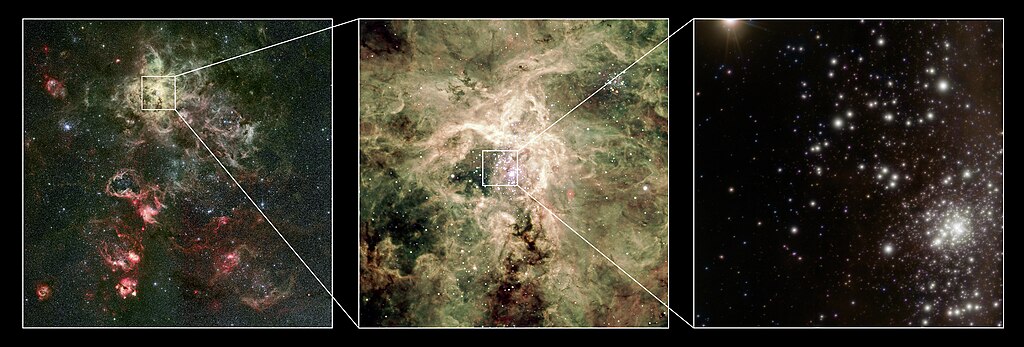ESO - Eso1030a (by)
R136 is a cluster of young, massive and hot stars located inside the Tarantula Nebula, in one of the neighbourhood galaxies of the Milky Way, the Large Magellanic Cloud, 165 000 light-years away. R136 contains so many stars that on a scale equivalent to the distance between the Sun and the nearest star there are tens of thousands of stars. Hundreds of these stars are so incredibly bright that if we were to sit on a (hypothetical) planet in the middle of the cluster the sky would never get dark.
This montage shows a visible-light image of the Tarantula nebula as seen with the Wide Field Imager on the MPG/ESO 2.2-metre telescope (left) along with a zoomed-in visible-light image from the Very Large Telescope (middle). A new image of the R136 cluster, obtained with the near-infrared MAD adaptive optics instrument on the Very Large Telescope is shown in the right-hand panel, with the cluster itself at the lower right. The MAD image provides unique details on the stellar content of the cluster. |
This media was created by the European Southern Observatory (ESO).
Their website states: "Unless specifically noted, the images, videos, and music distributed on the public ESO website, along with the texts of press releases, announcements, pictures of the week, blog posts and captions, are licensed under a Creative Commons Attribution 4.0 International License, and may on a non-exclusive basis be reproduced without fee provided the credit is clear and visible." To the uploader: You must provide a link (URL) to the original file and the authorship information if available. |
Denna fil har gjorts tillgänglig under licensen Creative Commons Erkännande 4.0 Internationell.
| |
Mer information om licensen för bilden finns här. Senaste uppdateringen: Sat, 12 Oct 2024 04:19:29 GMT
